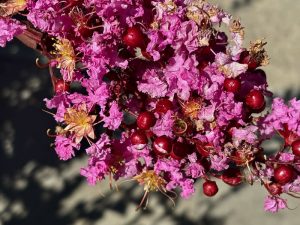Lagerstroemia ‘Delta Fuchsia™’: A Striking Crapemyrtle with Bold Color and Resilience
Lagerstroemia ‘Delta Fuchsia™’ is a standout cultivar in the Delta Series of Crapemyrtles, celebrated for its dramatic foliage and strikingly vivid blooms. This deciduous shrub or small tree features deep burgundy, glossy leaves that gracefully curve and shimmer in the sunlight, setting a vibrant backdrop for its brilliant fuchsia-pink flowers. Bred for resilience and ornamental beauty, this variety brings season-long interest to sunny landscapes and excels in regions with hot summers and mild winters.
As a patented variety (Lagerstroemia indica ‘Delef’ PP27668), ‘Delta Fuchsia™’ is part of the Lythraceae family and was cultivated to provide exceptional mildew resistance, excellent reblooming characteristics, and compact, manageable growth. It’s a show-stopping garden feature from summer through fall, ideal for southern gardens or any USDA Zone 7–9 location.
Characteristics of Lagerstroemia ‘Delta Fuchsia™’
This crapemyrtle or Lagerstroemia ‘Delta Fuchsia™’ boasts an upright habit, growing 8–12 feet (2.4–3.6 meters) tall and spreading 4–6 feet (1.2–1.8 meters) wide. It develops into a graceful multi-stemmed shrub or small tree, depending on pruning style. The foliage emerges in spring as a rich maroon, retaining its dark tones through the season and contrasting beautifully with the glowing pink flowers borne in large panicles.
The plant begins blooming in early summer and continues through fall, especially when you regularly deadhead the spent flowers. The blooms are not only ornamental but also attract butterflies, bees, and other pollinators.
This cultivar is deciduous, revealing attractive exfoliating bark in winter and offering moderate fall color in shades of orange to red. It’s a four-season plant with changing aesthetics that suit formal or informal garden designs alike.
How to Grow Lagerstroemia ‘Delta Fuchsia™’
Light
Lagerstroemia ‘Delta Fuchsia™’ thrives in full sun. At least 6 to 8 hours of direct sunlight per day is essential for strong blooming and mildew resistance. Shady locations will reduce flower production and make the plant more susceptible to disease.
Soil
This variety is adaptable to many soil types, including loamy, sandy, or clay soils, provided they are well-drained. It tolerates slightly acidic to neutral pH (pH 6.0 to 7.5). Amending clay soil with organic matter will enhance drainage and root development.
Watering
Water thoroughly at planting time, then maintain medium moisture as the plant becomes established. Once established, ‘Delta Fuchsia™’ is considered moderately drought tolerant. Deep watering every 7–14 days during dry spells encourages deep root growth and supports flowering.
Avoid overhead watering to reduce risk of foliar diseases. Mulching with 1–2 inches (2.5–5 cm) of organic mulch will retain soil moisture and suppress weeds, but keep mulch away from the trunk base.
Fertilizing
Feed in early spring with a balanced, slow-release fertilizer (e.g., 10-10-10 or 14-14-14) just before new growth emerges. Avoid high-nitrogen fertilizers, which promote foliage growth at the expense of flowering. Excess fertilization can also increase winter damage risk.
Pruning
- Shaping: Prune in late winter to shape the plant or maintain size. Avoid excessive topping, which can ruin the plant’s natural form.
- Deadheading: Remove spent flower heads throughout the blooming season to encourage reblooming.
- Winter Care: In colder zones like USDA 6, stems may die back to the ground. Prune back dead stems in early spring, and the plant will regrow from the base.
Propagation of Lagerstroemia ‘Delta Fuchsia™’
As a patented plant, Lagerstroemia ‘Delta Fuchsia™’ cannot be legally propagated without permission from the patent holder. Commercial propagation is restricted.
Pests and Diseases
This cultivar, Lagerstroemia ‘Delta Fuchsia™’, is specially bred for resistance to powdery mildew and aphids, two common issues with older crapemyrtle varieties. Occasional pests may include Japanese beetles or leafhoppers, but these are rarely problematic.
Avoid overwatering or poorly drained soil to prevent root rot. If powdery mildew does appear in damp climates, improve air circulation and ensure full sun exposure.
Environmental Lagerstroemia ‘Delta Fuchsia™’
- Heat Tolerance: Excellent, making it ideal for Southern gardens.
- Cold Hardiness: Hardy to 0–10°F (-18 to -12°C). Best in USDA Zones 7a to 9b. In colder zones, treat as a dieback shrub similar to buddleia.
- Drought Resistance: Once established, it is water-wise and suitable for xeriscaping.
Design Uses for Delta Fuchsia™
This dynamic cultivar serves many roles in the landscape:
- Accent Specimen: Showcases seasonal color as a standalone feature.
- Hedge or Privacy Screen: Plant in rows for a flowering privacy barrier.
- Container Planting: Performs well in large containers with proper drainage.
- Mass Planting: For a bold swath of color and structure in public spaces.
- Wildlife Garden: Attracts birds and pollinators with nectar-rich flowers.
Its compact habit makes it ideal for urban and suburban gardens where space is limited but impact is desired.
Seasonal Interest and Maintenance Tips
- Spring: New growth emerges burgundy; fertilize and mulch.
- Summer: Peak flowering; deadhead to extend bloom.
- Fall: Last wave of flowers; enjoy exfoliating bark and fall color.
- Winter: Prune in late winter before new growth begins.
In colder zones, apply a protective mulch over the root zone in late fall and prune back dead wood in early spring. In warmer climates, shape as a small tree with regular structural pruning.
Final Thoughts on Lagerstroemia ‘Delta Fuchsia™’
Lagerstroemia ‘Delta Fuchsia™’ delivers bold color and strong structure with minimal maintenance. Its ability to rebloom throughout summer, resist disease, and withstand heat and drought make it a modern classic in Southern landscapes. Gardeners seeking a long-blooming, pollinator-friendly shrub that thrives in full sun should consider this showy crapemyrtle a top pick.



